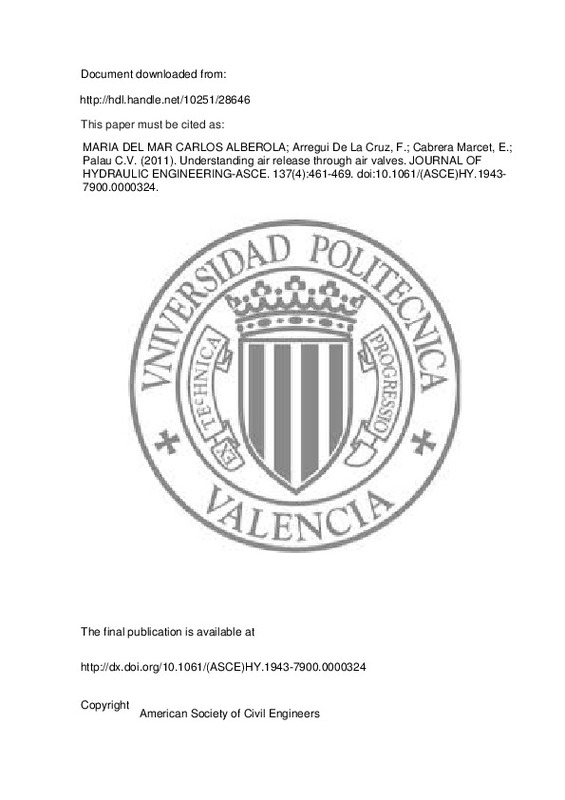Carlos Alberola, MDM.; Arregui De La Cruz, F.; Cabrera Marcet, E.; Palau, C. (2011). Understanding air release through air valves. Journal of Urban Planning and Development. 137(4):461-469. doi:10.1061/(ASCE)HY.1943-7900.0000324
Por favor, use este identificador para citar o enlazar este ítem: http://hdl.handle.net/10251/28646
|
Título:
|
Understanding air release through air valves
|
|
Autor:
|
Carlos Alberola, María del Mar

 Arregui de la Cruz, Francisco
Arregui de la Cruz, Francisco
 Cabrera Marcet, Enrique
Cabrera Marcet, Enrique

 Palau, C.V.
Palau, C.V.
|
|
Entidad UPV:
|
Universitat Politècnica de València. Departamento de Ingeniería Rural y Agroalimentaria - Departament d'Enginyeria Rural i Agroalimentària
Universitat Politècnica de València. Departamento de Ingeniería Hidráulica y Medio Ambiente - Departament d'Enginyeria Hidràulica i Medi Ambient
|
|
Fecha difusión:
|
|
|
Resumen:
|
[EN] Water transients with entrapped air can originate large pressure peaks that can severely damage distribution networks. Entrapped air can have a damping or amplifying effect on these undesirable pressure peaks. ...[+]
[EN] Water transients with entrapped air can originate large pressure peaks that can severely damage distribution networks. Entrapped air can have a damping or amplifying effect on these undesirable pressure peaks. Unfortunately, the complexity of the phenomenon too often makes it difficult to obtain a fully reliable prediction about when air pockets will mitigate or accentuate water transients. Furthermore, the value of some of the parameters involved in the conventional numerical models cannot be calculated or measured and need to be determined through a calibration process. With the aim of overcoming most of the aforementioned uncertainties, this paper summarizes a complete set of tests conducted at WL | Delft Hydraulics. These tests were simulated by means of a tailored numerical model that includes a set of parameters whose values were determined by means of a calibration process. The experimental setup, a large-scale facility, consisted of a single steep pipeline with an air valve installed at its top end. Air release through different air valves was tested under different conditions. © 2011 American Society of Civil Engineers.
[-]
|
|
Palabras clave:
|
Air valves
,
Entrapped air
,
Transient analysis
,
Air pockets
,
Amplifying effect
,
Calibration process
,
Damage distribution
,
Experimental setup
,
Numerical models
,
Pressure peaks
,
Calibration
,
Computer simulation
,
Numerical methods
,
Pressure effects
,
Valves (mechanical)
,
Airflow
,
Entrainment
,
Numerical model
,
Pipeline
|
|
Derechos de uso:
|
Reserva de todos los derechos
|
|
Fuente:
|
Journal of Urban Planning and Development. (issn:
0733-9429
)
|
|
DOI:
|
10.1061/(ASCE)HY.1943-7900.0000324
|
|
Editorial:
|
American Society of Civil Engineers
|
|
Versión del editor:
|
http://dx.doi.org/10.1061/(ASCE)HY.1943-7900.0000324
|
|
Código del Proyecto:
|
info:eu-repo/grantAgreement/EC/FP5/G1RT-CT-2002-05069/EU/Organisations involved in the prediction and analysis of fluid transients in pipe systems/
|
|
Agradecimientos:
|
This research has been possible thanks to the European Community Programme "Access to Major Research Infrastructure" under the Fifth Framework Growth Programme (Contract No. GIRT-CT-2002-05069).
|
|
Tipo:
|
Artículo
|







![[Cerrado]](/themes/UPV/images/candado.png)


